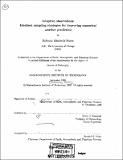| dc.contributor.advisor | Kerry A. Emanuel. | en_US |
| dc.contributor.author | Morss, Rebecca Elisabeth, 1972- | en_US |
| dc.date.accessioned | 2010-05-25T20:36:48Z | |
| dc.date.available | 2010-05-25T20:36:48Z | |
| dc.date.copyright | 1998 | en_US |
| dc.date.issued | 1999 | en_US |
| dc.identifier.uri | http://hdl.handle.net/1721.1/55060 | |
| dc.description | Thesis (Ph.D.)--Massachusetts Institute of Technology, Dept. of Earth, Atmospheric, and Planetary Sciences, February 1999. | en_US |
| dc.description | Includes bibliographical references (p. 221-225). | en_US |
| dc.description.abstract | The purpose of adaptive observations is to use information about individual atmospheric situations to identify regions where additional observations are likely to improve weather forecasts of interest. The observation network could be adapted for a wide range of forecasting goals, and it could be adapted either by allocating existing observations differently or by adding observations from programmable platforms to the existing network. In this study, we explore observation strategies in a simulated idealized system with a three-dimensional quasi-geostrophic model and a realistic data assimilation scheme. Several issues are addressed, including whether adapting observations has potential to improve forecasts, how observational resources can be optimally allocated in space and time, how effectively ensemble forecasts can estimate errors in initial conditions, and how much the data assimilation system affects the influence of the observations. Using simple error norms, we compare idealized non-adaptive observations with adaptive observations for a variety of observation densities. The adaptive strategies implemented incorporate information only about errors in the initial conditions. We test both an idealized adaptive strategy, which selects observation locations based on perfect knowledge of the true atmospheric state, and a more realizable adaptive strategy, which uses an ensemble to estimate errors in the initial conditions. We find that the influence of the observations, both adaptive and non-adaptive, depends strongly on the observation density. In this simulated system, observations on synoptic scales dominate the average error reduction; above a certain observation density, adding any observations, adaptive or non-adaptive, has a much smaller effect. Results presented show that for non-dense observation networks, the adaptive strategies tested can, on average in this simulated system, reduce analysis and forecast errors by a given amount using fewer observational resources than the non-adaptive strategies. In contrast, however, our results suggest that it is much more difficult to benefit from modifying the observation network for dense observation networks, for adaptive observations taken infrequently, or for additional observations taken to improve forecasts in individual cases. The interactions between the observations, the data assimilation system, the errors in the initial conditions, and the forecast model are complex and depend on the specific forecast situation. This leads to a non-negligible risk that forecasts will be degraded when observations are adapted in an individual situation. Further study is needed both to understand these interactions better and to learn to what extent the results from this idealized study apply to more complex, more realistic systems. | en_US |
| dc.description.statementofresponsibility | by Rebecca Elisabeth Morss. | en_US |
| dc.format.extent | 225 p. | en_US |
| dc.language.iso | eng | en_US |
| dc.publisher | Massachusetts Institute of Technology | en_US |
| dc.rights | M.I.T. theses are protected by
copyright. They may be viewed from this source for any purpose, but
reproduction or distribution in any format is prohibited without written
permission. See provided URL for inquiries about permission. | en_US |
| dc.rights.uri | http://dspace.mit.edu/handle/1721.1/7582 | en_US |
| dc.subject | Earth, Atmospheric, and Planetary Sciences | en_US |
| dc.title | Adaptive observations : idealized sampling strategies for improving numerical weather prediction | en_US |
| dc.title.alternative | Idealized sampling strategies for improving numerical weather prediction | en_US |
| dc.type | Thesis | en_US |
| dc.description.degree | Ph.D. | en_US |
| dc.contributor.department | Massachusetts Institute of Technology. Department of Earth, Atmospheric, and Planetary Sciences | |
| dc.identifier.oclc | 42583576 | en_US |
